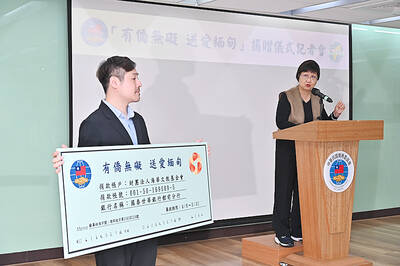The Democratic Progressive Party (DPP) yesterday published a picture book entitled Rainbow Formosa: Taiwan Ethnic History, to commemorate the 25th anniversary of the Formosa Incident.
Independence Roots
The Formosa Incident, also known as Kaohsiung Incident, occurred on Dec. 10, 1979, when a demonstration organized by opposition politicians and Formosa Magazine to commemorate Human Rights Day turned into a bloody riot which led to the arrest of a group of the then political dissidents, including now Vice President Annette Lu (
Deputy Premier Yeh Chu-lan (葉菊蘭), DPP Deputy Secretary-General Lee Ying-yuan (李應元) and DPP Information and Culture Department Director Cheng Wen-tsan (
DPP Resolution
The book features the party's resolution to seek national unity through the co-existence of ethnic communities in an innovative and lively way, according to a statement by the DPP.
The statement noted that the picture book features the notions of love and unity and emphasizes that Taiwan's diverse cultures are an essential part of "Rainbow Formosa."
The book calls for the formation of a civic spirit to consolidate the notion of "our country is Taiwan," according to the statement.
In the book's introduction, Premier Yu Shyi-kun writes that the DPP hopes that through the promotion of the concept of civil rights, all ethnic cultures in the country can receive equal attention in terms of development.
He also expresses the hope that Taiwan can become a place where "ethnic diversity and national unity exist."

Taiwan is stepping up plans to create self-sufficient supply chains for combat drones and increase foreign orders from the US to counter China’s numerical superiority, a defense official said on Saturday. Commenting on condition of anonymity, the official said the nation’s armed forces are in agreement with US Admiral Samuel Paparo’s assessment that Taiwan’s military must be prepared to turn the nation’s waters into a “hellscape” for the Chinese People’s Liberation Army (PLA). Paparo, the commander of the US Indo-Pacific Command, reiterated the concept during a Congressional hearing in Washington on Wednesday. He first coined the term in a security conference last

DEFENSE: The National Security Bureau promised to expand communication and intelligence cooperation with global partners and enhance its strategic analytical skills China has not only increased military exercises and “gray zone” tactics against Taiwan this year, but also continues to recruit military personnel for espionage, the National Security Bureau (NSB) said yesterday in a report to the Legislative Yuan. The bureau submitted the report ahead of NSB Director-General Tsai Ming-yen’s (蔡明彥) appearance before the Foreign and National Defense Committee today. Last year, the Chinese People’s Liberation Army (PLA) conducted “Joint Sword-2024A and B” military exercises targeting Taiwan and carried out 40 combat readiness patrols, the bureau said. In addition, Chinese military aircraft entered Taiwan’s airspace 3,070 times last year, up about

A magnitude 4.3 earthquake struck eastern Taiwan's Hualien County at 8:31am today, according to the Central Weather Administration (CWA). The epicenter of the temblor was located in Hualien County, about 70.3 kilometers south southwest of Hualien County Hall, at a depth of 23.2km, according to the administration. There were no immediate reports of damage resulting from the quake. The earthquake's intensity, which gauges the actual effect of a temblor, was highest in Taitung County, where it measured 3 on Taiwan's 7-tier intensity scale. The quake also measured an intensity of 2 in Hualien and Nantou counties, the CWA said.

The Overseas Community Affairs Council (OCAC) yesterday announced a fundraising campaign to support survivors of the magnitude 7.7 earthquake that struck Myanmar on March 28, with two prayer events scheduled in Taipei and Taichung later this week. “While initial rescue operations have concluded [in Myanmar], many survivors are now facing increasingly difficult living conditions,” OCAC Minister Hsu Chia-ching (徐佳青) told a news conference in Taipei. The fundraising campaign, which runs through May 31, is focused on supporting the reconstruction of damaged overseas compatriot schools, assisting students from Myanmar in Taiwan, and providing essential items, such as drinking water, food and medical supplies,